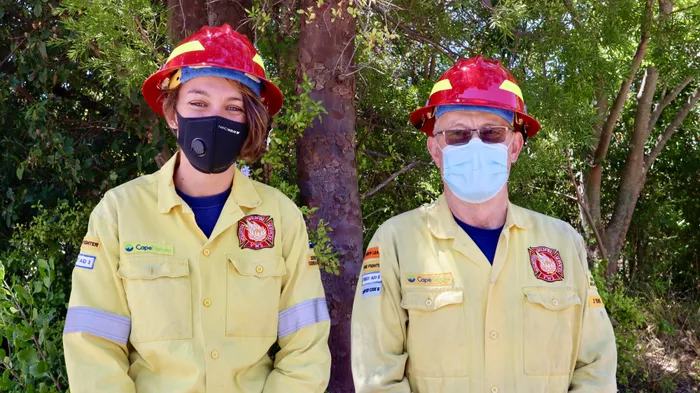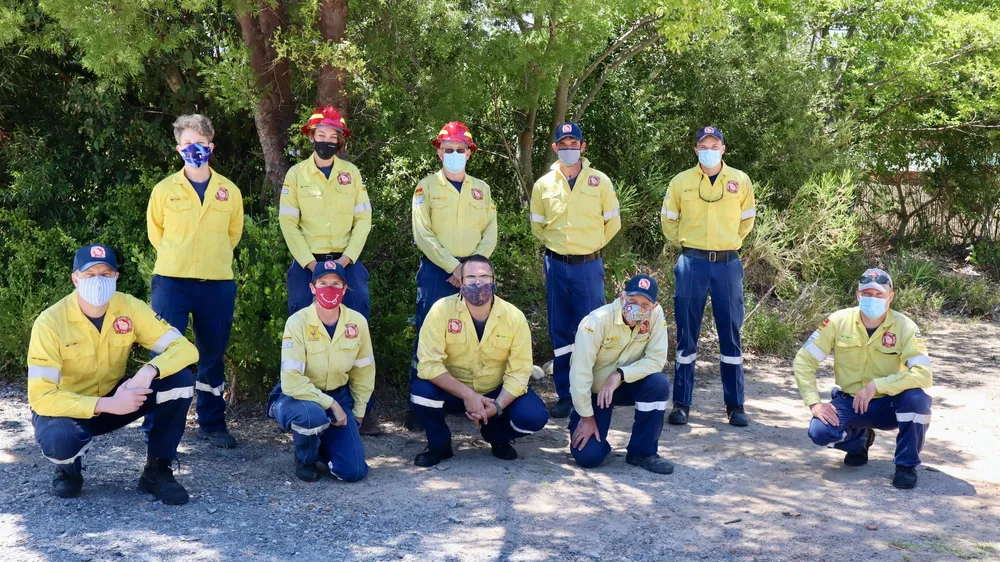Red helmets for VWS fire-fighters

Volunteer Wildfire Services (VWS) firefighters, Deidré Odendaal and Norman McFarlane, pictured, who were recently appointed Crew Leader, received their red helmets at a handover ceremony on Saturday at the VWS Grabouw firebase at Helderberg Nature Reserve, during weekend base standby.

Bolander asked Deidré Odendaal and Norman McFarlane, new recipients of the hard won red helmets worn by Volunteer Wildfire Services (VWS) fire-fighting crew leaders, about the path that led them to join this intrepid organisation of yellow-clad men and women, who scale mountains and valleys in the dead of night or the middle of the day, battling intense temperatures and untold dangers, to battle fires, carrying heavy equipment and possessed by the singular determination to extinguish the flames, and often save property and homes in the process.
When and why did you join VWS?
Deidré: I joined the VWS in 2015 with my two younger sisters. We love the outdoors, doing things together and try to help where we can – and it looked like quite an adventure and we love adventures.
Norman: I covered a number of fires as a journalist while working for Bolander, and I was appalled at the destruction that I witnessed. In 2016, I decided that it wasn’t enough to just tell the stories of those fires. I felt I wanted to do more, to get involved, so I signed up with the VWS during an open day event at Lourensford Wine Estate, in time for the 2017 training season.
How did your first training season and fire season go?
Deidré: The first training season was tough, but exhilarating and it was all worth it when we got to beat our first flames!!
Norman: I grossly underestimated how tough and demanding the training was to qualify as a firefighter, but I was determined, so I toughed it out. My first fire, in November 2017 above Gordon’s Bay, was a revelation. Despite my certainty that qualifying as a firefighter meant the hard work was behind me, that experience made me really just how important physical fitness and stamina is in woodland firefighting. It was a tough season, but I loved being able to get out onto the wireline, and beat down flames.
What is it about wildland firefighting that you find the most rewarding?
Deidré: Being out in nature and meeting the amazing people from all walks of life who make the time in their busy schedules to make a difference in the world.
Norman: It’s arguably the community initiative that affords you the most immediate satisfaction. You get to see the fruits of our labours on the wireline, and you also get to visit places, often high in the mountains where many of the fires occur, that most other human beings never get to see.
What motivated you to become a crew leader?
Deidré: I love motivating people to push themselves to do more than they think they are capable of – as well as getting people to work together to achieve something great.
Norman: I started firefighting relatively late in life – I was 62 when I first qualified – so I didn’t anticipate being able to become a crew leader, but as time passed, and I realised how much I loved it, I began to aspire to becoming a crew leader. I’m honoured and deeply humbled that my (now) fellow crew leaders (it is a peer review process) adjudged me suitable for fireline leadership.
What do you do for a living?
Deidré: I work in the agricultural industry and assist farmers with pest and disease control in their crops.
Norman: I’m retired!
How do you juggle a busy life/career with your volunteer firefighting?
Deidré: Life is such a rush and can be so draining and stressful – it is so important to make time to do things you are passionate about, where you find your peace – firefighting is one of the places where I find my peace.
Norman: Having retired at the end of December, I have more flexibility in my schedule, and although I still need to work for a living, I have the freedom to devote more time to the VWS.